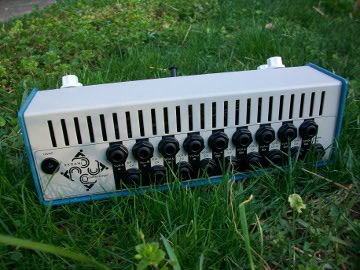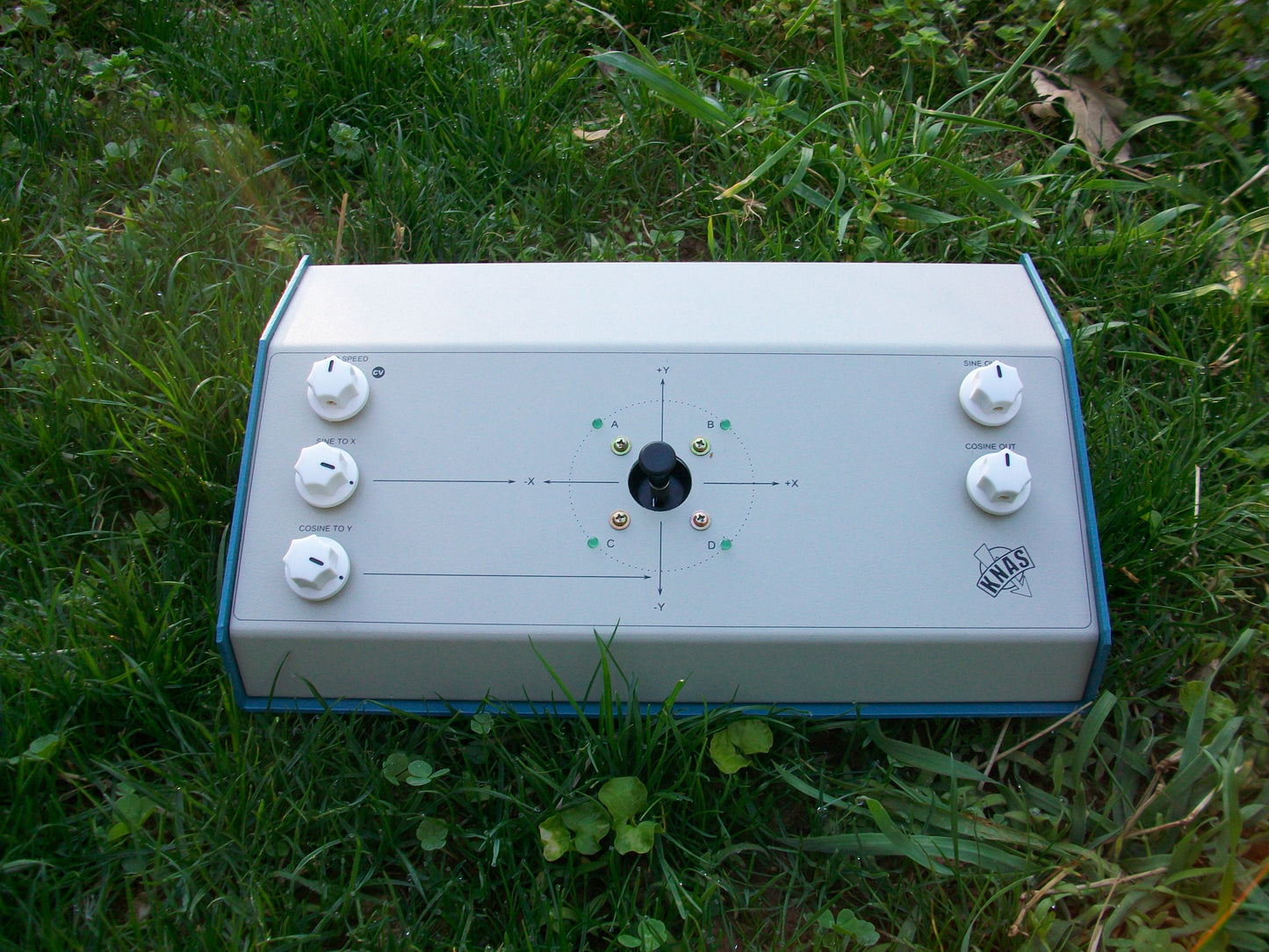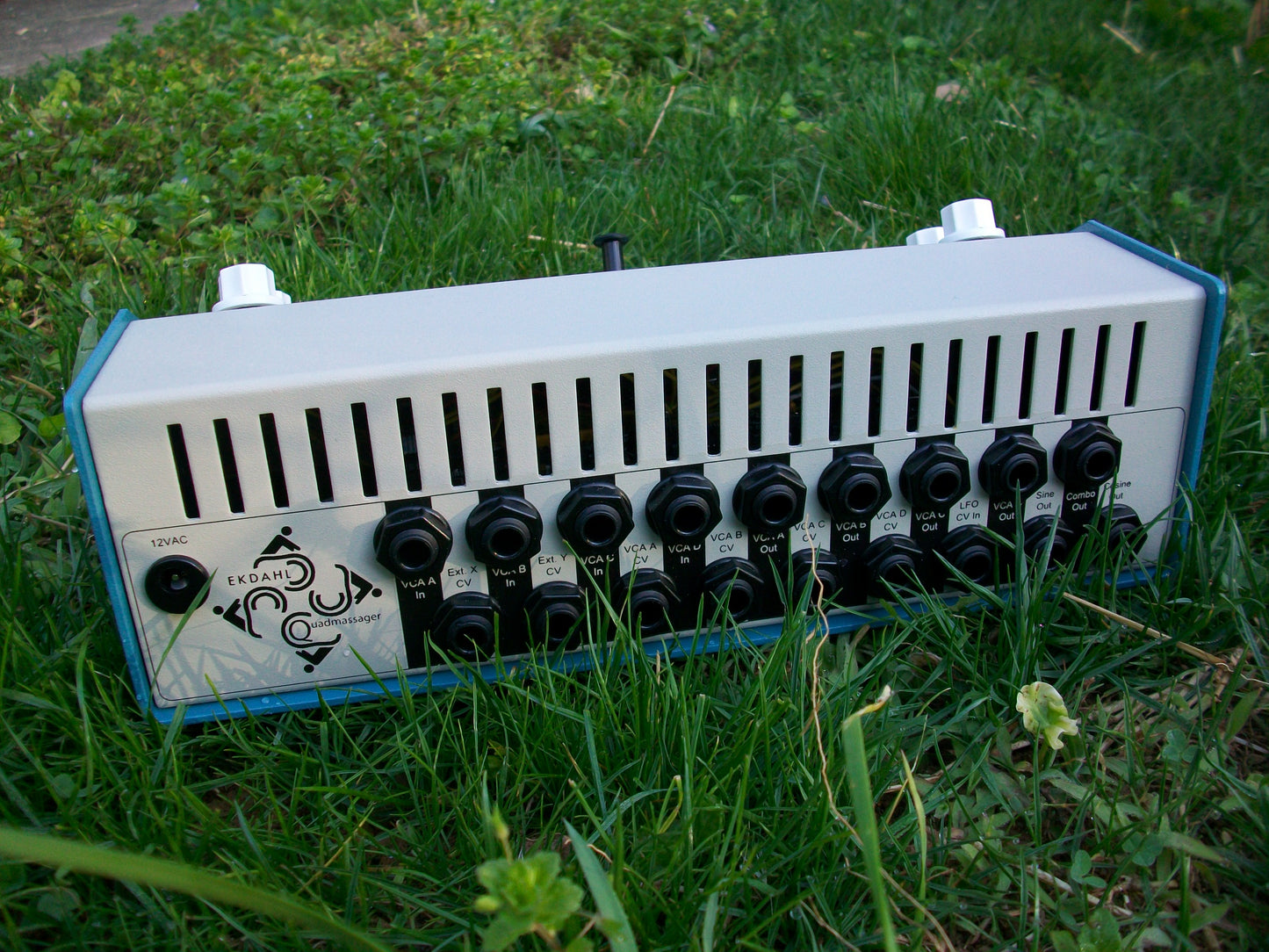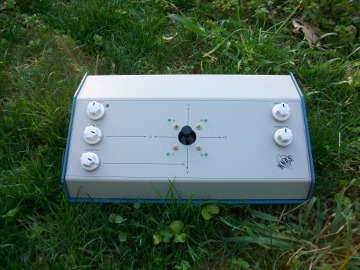Knas
Ekdahl Quad Massager
Ekdahl Quad Massager
Impossibile caricare la disponibilità di ritiro
It's a Classic!
Analog CV controlable quadraphonic mixer!
Shipping Early Jan 2025
Now Includes EU PSU YAY!
The Ekdahl Quad Massager is a quad VCA, joystick-controlled mixer / quadrophonic panner for Audio or CV. It comes with a voltage-controlled quadrature sine LFO and no less than 18 x 1/4" ins and outs.
In short, the Ekdahl Quad Massager can be used to "move" a signal on a 2-dimensional surface, giving the effect of quadrophonic panning. In reality, the joystick position only sets the volume of the four outputs. At center position all outputs are at their maximum output volume, the further the joystick moves from the center, the less the amplitude of the opposed outputs of the travel.
 Each output is controlled by a VCA, each VCA has one signal input, one signal output and one CV input. If connected, the direct CV input breaks the connection to the joystick and LFO routing so that the VCA can be used as stand-alone. The Ekdahl Quad Massager also has CV inputs for both the X and Y axis, serving the same function as the joystick movements.
Each output is controlled by a VCA, each VCA has one signal input, one signal output and one CV input. If connected, the direct CV input breaks the connection to the joystick and LFO routing so that the VCA can be used as stand-alone. The Ekdahl Quad Massager also has CV inputs for both the X and Y axis, serving the same function as the joystick movements.
The Ekdahl Quad Massager is equipped with a voltage-controlled quadrature LFO that can give both sine and cosine outputs. Traditionally, the LFO is used to move the sound in circular or elliptical patterns as well as back and forth along either the X or Y axis. The LFO also has two CV outputs (Sine / Cosine) and one CV input (Speed). The X and Y axises CV input goes full range on +/-2.5V, the direct VCA CV inputs reacts to 0-5V.
- VCA A In - whatever sound you wanna pan
- VCA A Out - Left front speaker
- VCA B Out - Right front speaker
- VCA C Out - Left rear speaker
- VCA D Out - Right rear speaker
- Combination Out - subwoofer (optional)
Use:
Manual panning: set the "cosine to y" knob to 0 and the "sine to x" knob to 0 and move the joystick around.
Automatic panning: to have automatic panning controlled by the internal LFO, set for example the "cosine to y" knob to 25% and the "sine to x" knob to 25% and set the "LFO Speed" knob to 25% - this will create circular panning. By changing the "cosine to y" knob and "sine to x" knob to different values from eachother, eliptical panning movements will result. By setting either knob to 0, panning will only happen either left-to-right or front-to-back.
Note about patching: by putting an audio cable into the "VCA A In" jack and leaving the "VCA B In", "VCA C In" and "VCA D In" jack disconnected, the audio from the "VCA A In" jack will automatically be connected to the other inputs - it's like if you had four cables, from the same source going to the four inputs. The way it works is quite simple: audio from "VCA A In" goes to "VCA B In" which in turn goes to "VCA C in" which then goes to "VCA D In", this means that if you connect two sources, one to "VCA A In" and one to "VCA C In", it works like this:
VCA A In -> VCA B In and VCA C In -> VCA D In
- VCA A In - Audio source left
- VCA C In - Audio source right
- VCA A Out - Left front
- VCA B Out - Left rear
- VCA C Out - Right front
- VCA D Out - Right rear
- Combination Out - subwoofer (optional)
- VCA A In - Audio source 1
- VCA B In - Audio source 2
- VCA C In - Audio source 3
- VCA D In - Audio source 4
- Combination Out - to your amp, mixer, stereo, whatever you got
- VCA A In - Audio source 1
- VCA B In - Audio source 2
- VCA C In - Audio source 3
- VCA D In - Audio source 4
- VCA A Out - Speaker 1
- VCA B Out - Speaker 2
- VCA C Out - Speaker 3
- VCA D Out - Speaker 4
Inserting a cable into any of the "VCA [X] CV In" will disconnect the VCA from the joystick action and make it work as a standalone VCA.
- VCA A In - Audio source
- VCA A Out - To your amp, mixer etc.
- VCA A CV In - To your CV-source (ADSR, LFO etc.)
Note: This requires the "carrier audio" to be a very loud signal like that of a modular synthesizer, a preamp could be used to bring a line-level signal to the desired volume. This does not result in "true" ring-modulation but is close enough and sounds awesome, no complaining.
- VCA A In - Audio source to be ring-modulated
- VCA A CV In - Audio source that is the "carrier audio", that controls the modulation
- VCA A Out - To your amp, mixer etc.





